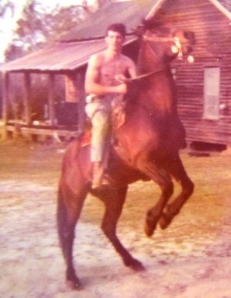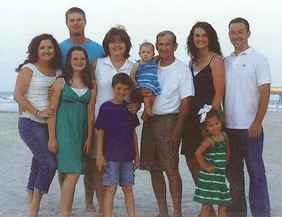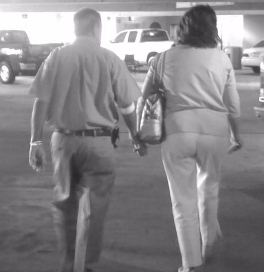Sharecropper's Son Continues To Spur His Mesothelioma
Charles Copeland is a 64 year-old native Georgian and the son of a sharecropper born and raised in Valdosta, Georgia. As a youngster, Charles shared the dining room table with 12 siblings. Instead of “please pass the gravy” it was every man and woman for themselves.
Charles was number eight in the Copeland brood. So in effect, he was always one of the “little kids”, not one of the “big kids.” Not in the top tier of the unofficial pecking order, he was not the youngest either. That position allowed him to be BIG brother to four Copelands.
His father, J.W. Copeland worked as a sharecropper in Valdosta. J.W. primarily planted and harvested corn and tobacco. In the late 1960’s, J.W. opened a small grocery store in Naylor, Georgia. Naylor is a very small city located just east of Valdosta. Naylor is small enough that the four Naylor City Limits signs occupied the same pole at the same intersection.
All the Copeland children were introduced to the value of hard work at a young age. In his younger years, Charles took to riding horses. He was so good at it that local ranchers would ask him to break in some of the newer horses.

As he grew older, Charles never left the joy and peace of being outdoors. His horse riding days dwindled but his hunting and fishing days increased. He has been married to his lovely wife Cathy since 1971 and together they have two daughters and four grandchildren.
In March of 2009, Charles’s daughter Jodie noticed that Charles had lost significant weight but had a bloated stomach in addition to having “bad color.” She urged him to see their family physician. At that time, Charles was not suffering from any symptoms, just a minor lack of energy and a pain in his side. He attributed the pain to a pulled muscle.
On March 31, Charles met with the doctors who took films of the chest and abdomen. The CT of the abdomen revealed omental caking consistent with omental metastasis. Also noted was peritoneal thickening and slight nodularity consistent with peritoneal metastases and the presence of fluid.
Charles was admitted to the Southern Georgia Medical Center in Valdosta for further tests. On April 2, Charles underwent his first paracentesis. Analysis of the fluid showed small clusters, sheets and benign reactive mesothelial cells.
At Southern Georgia, Charles underwent an additional CT scan, blood work and an ultrasound. The results were very suspicious of cancer. One of his doctors wanted to perform an open biopsy to determine what type of cancer had invaded Charles’s peritoneum.
The Copeland family was hesitant about what seemed to be a pretty drastic diagnostic procedure and asked if there was anyone else they could consult for a second opinion. His doctor then arranged for Charles to see a gastroenterologist associated with the Mayo Clinic in Jacksonville, Florida.

Charles consulted with the doctors in Jacksonville in April. The gastroenterologist wanted to determine the primary cancer site and Charles subsequently underwent an endoscopy and colonscopy, neither of which were diagnostic.
On June 5, 2009, Charles underwent a laparoscopy at the Mayo Clinic. The pathology report returned a diagnosis of malignant mesothelioma. Charles then consulted with oncologists at the Pearlman Cancer Center in Valdosta who began treating him with a regiment of Alimta/Carboplain chemotherapy
From July of 2009 to May of 2010, Charles underwent three weeks of treatment, followed by a CT scan and then another cycle. A CT scan in May showed significant regression of the mesothelioma so Charles was told he could take a break from the chemotherapy and to return every three months for a follow-up. Since his diagnosis in 2009, Charles continued to work, even the day after his chemotherapy treatments. He scheduled his treatments on Thursdays knowing he would not be feeling well on the weekends and could rest up for the coming work week.
In August of 2011, a CT scan revealed the fluid had returned. Another CT scan in October showed even more fluid in the peritoneal cavity. Charles was then treated with Gemcitabine for the next two months. When subsequent CT scans showed the Gemcitabine was not slowing down the cancer, Charles began treatment using Vinorelbine.
In December of 2011, Charles has been receiving one treatment a week of Vinorelbine.
Since October of 2012, Charles has been receiving Doxorucin, one treatment every three weeks. He also has the fluid drained from his abdomen approximately once a week.

The only semi-positive thing that could come from Charles’ diagnosis was the opportunity to be introduced to Tom Bradford, a fellow peritoneal survivor who is currently participating in a clinical trial at the M.D. Anderson Cancer Center in Houston, Texas. Over the past year, the two have become close friends.
In 1971, Charles’ brother purchased land about 15 miles outside of town. Since then the family has built several ponds, planted pine trees and built a small two story home. The place is referred to as The Family Farm and is shared by all the Copeland families. Instead of traveling to other states or countries, the Copeland families would rather gather at the farm, cook hot dogs, hamburgers and gator and watch the geese swim and the deer eat the newly planted corn.
These days, Charles tires easily and does not have the strength he had just over one year ago. He continues to take his grandson fishing at the Family Farm but can only sit and watch, “I can’t throw a reel anymore, it takes too much out me.”
Now, as a rule, before any hook gets wet, Charlie has to have breakfast, his favorite meal of the day. And what is for breakfast today…and every day Charlie? Why biscuits and gravy of course.
*** Posted on March 6, 2013 ***
*** Charles Copeland passed away on November 14, 2013 ***


